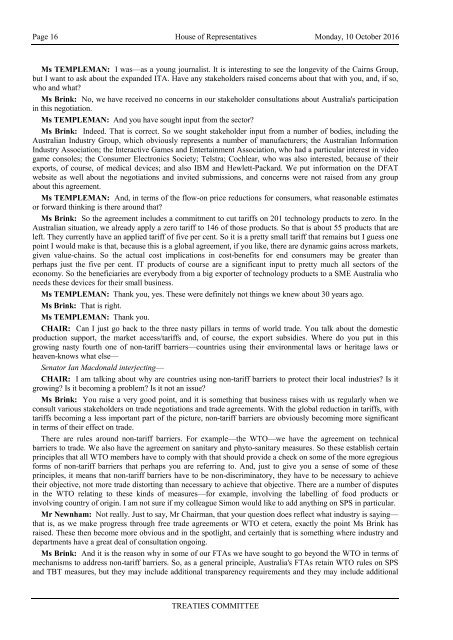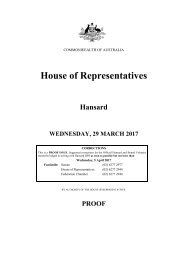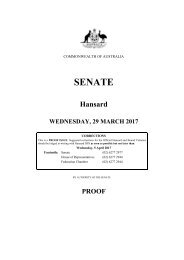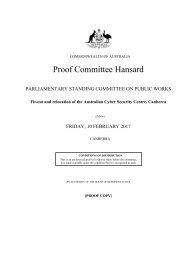Proof Committee Hansard
2d908Ic
2d908Ic
You also want an ePaper? Increase the reach of your titles
YUMPU automatically turns print PDFs into web optimized ePapers that Google loves.
Page 16 House of Representatives Monday, 10 October 2016<br />
Ms TEMPLEMAN: I was—as a young journalist. It is interesting to see the longevity of the Cairns Group,<br />
but I want to ask about the expanded ITA. Have any stakeholders raised concerns about that with you, and, if so,<br />
who and what?<br />
Ms Brink: No, we have received no concerns in our stakeholder consultations about Australia's participation<br />
in this negotiation.<br />
Ms TEMPLEMAN: And you have sought input from the sector?<br />
Ms Brink: Indeed. That is correct. So we sought stakeholder input from a number of bodies, including the<br />
Australian Industry Group, which obviously represents a number of manufacturers; the Australian Information<br />
Industry Association; the Interactive Games and Entertainment Association, who had a particular interest in video<br />
game consoles; the Consumer Electronics Society; Telstra; Cochlear, who was also interested, because of their<br />
exports, of course, of medical devices; and also IBM and Hewlett-Packard. We put information on the DFAT<br />
website as well about the negotiations and invited submissions, and concerns were not raised from any group<br />
about this agreement.<br />
Ms TEMPLEMAN: And, in terms of the flow-on price reductions for consumers, what reasonable estimates<br />
or forward thinking is there around that?<br />
Ms Brink: So the agreement includes a commitment to cut tariffs on 201 technology products to zero. In the<br />
Australian situation, we already apply a zero tariff to 146 of those products. So that is about 55 products that are<br />
left. They currently have an applied tariff of five per cent. So it is a pretty small tariff that remains but I guess one<br />
point I would make is that, because this is a global agreement, if you like, there are dynamic gains across markets,<br />
given value-chains. So the actual cost implications in cost-benefits for end consumers may be greater than<br />
perhaps just the five per cent. IT products of course are a significant input to pretty much all sectors of the<br />
economy. So the beneficiaries are everybody from a big exporter of technology products to a SME Australia who<br />
needs these devices for their small business.<br />
Ms TEMPLEMAN: Thank you, yes. These were definitely not things we knew about 30 years ago.<br />
Ms Brink: That is right.<br />
Ms TEMPLEMAN: Thank you.<br />
CHAIR: Can I just go back to the three nasty pillars in terms of world trade. You talk about the domestic<br />
production support, the market access/tariffs and, of course, the export subsidies. Where do you put in this<br />
growing nasty fourth one of non-tariff barriers—countries using their environmental laws or heritage laws or<br />
heaven-knows what else—<br />
Senator Ian Macdonald interjecting—<br />
CHAIR: I am talking about why are countries using non-tariff barriers to protect their local industries? Is it<br />
growing? Is it becoming a problem? Is it not an issue?<br />
Ms Brink: You raise a very good point, and it is something that business raises with us regularly when we<br />
consult various stakeholders on trade negotiations and trade agreements. With the global reduction in tariffs, with<br />
tariffs becoming a less important part of the picture, non-tariff barriers are obviously becoming more significant<br />
in terms of their effect on trade.<br />
There are rules around non-tariff barriers. For example—the WTO—we have the agreement on technical<br />
barriers to trade. We also have the agreement on sanitary and phyto-sanitary measures. So these establish certain<br />
principles that all WTO members have to comply with that should provide a check on some of the more egregious<br />
forms of non-tariff barriers that perhaps you are referring to. And, just to give you a sense of some of these<br />
principles, it means that non-tariff barriers have to be non-discriminatory, they have to be necessary to achieve<br />
their objective, not more trade distorting than necessary to achieve that objective. There are a number of disputes<br />
in the WTO relating to these kinds of measures—for example, involving the labelling of food products or<br />
involving country of origin. I am not sure if my colleague Simon would like to add anything on SPS in particular.<br />
Mr Newnham: Not really. Just to say, Mr Chairman, that your question does reflect what industry is saying—<br />
that is, as we make progress through free trade agreements or WTO et cetera, exactly the point Ms Brink has<br />
raised. These then become more obvious and in the spotlight, and certainly that is something where industry and<br />
departments have a great deal of consultation ongoing.<br />
Ms Brink: And it is the reason why in some of our FTAs we have sought to go beyond the WTO in terms of<br />
mechanisms to address non-tariff barriers. So, as a general principle, Australia's FTAs retain WTO rules on SPS<br />
and TBT measures, but they may include additional transparency requirements and they may include additional<br />
TREATIES COMMITTEE















